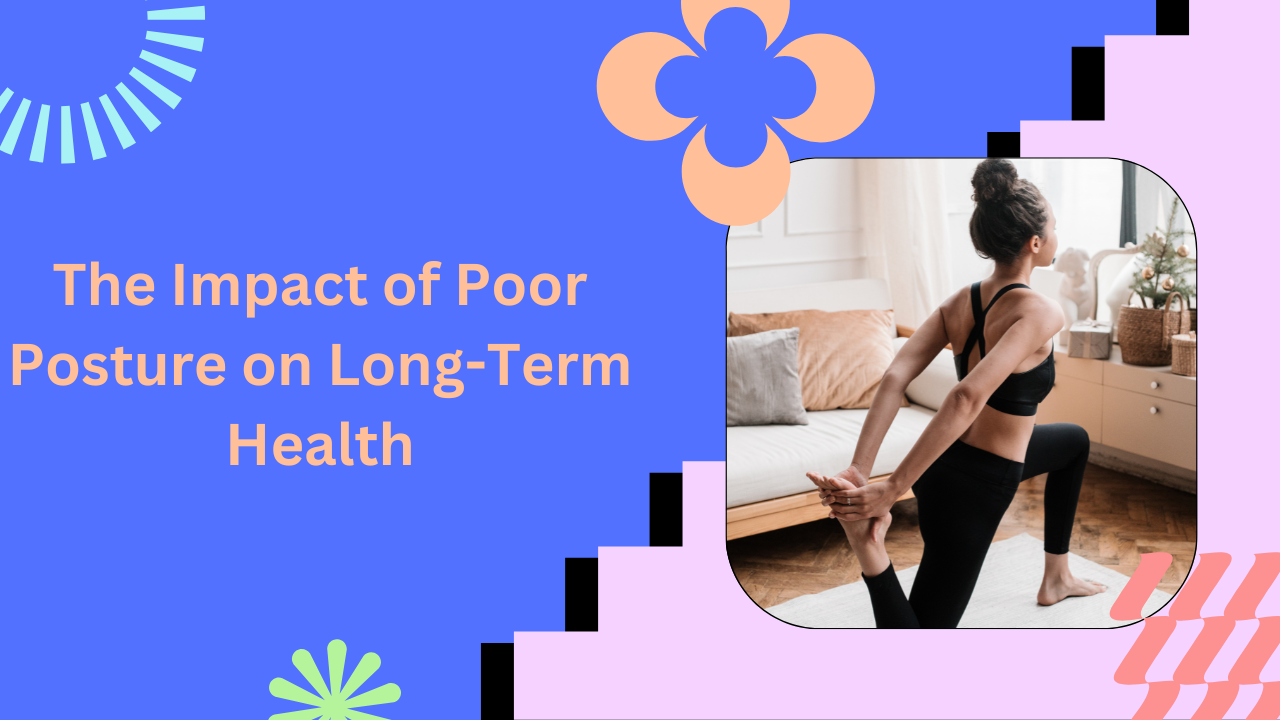Introduction
Have you ever felt an ache in your neck after hours of looking at your phone? Or experienced lower back pain after sitting for long periods? These discomforts are not just temporary annoyances but signs of poor posture, which can lead to severe health problems over time.
In today’s technology-driven world, people spend an average of 7-10 hours sitting daily at desks, using mobile devices, or driving. According to the American Chiropractic Association (ACA), slouching and improper spinal alignment contribute to 80% of back and neck pain cases.
But posture is not just about looking confident—it’s a fundamental aspect of long-term musculoskeletal health, organ function, and mental well-being. In this article, we’ll explore how poor posture affects your health and provide actionable strategies to improve it.
Understanding Poor Posture

What is Poor Posture?
Posture refers to the way we hold our bodies while sitting, standing, and moving. Good posture maintains the natural curves of the spine, while poor posture disrupts this alignment, causing strain on muscles and joints.
Common Types of Poor Posture
- Forward Head Posture (“Tech Neck”)
- Caused by constantly looking down at a phone or computer.
- Adds an extra 10-15 lbs of pressure on the cervical spine per inch forward.
- Hunchback Posture (Kyphosis)
- Rounded upper back and slumped shoulders.
- Often develops from prolonged sitting and weak back muscles.
- Anterior Pelvic Tilt
- Lower back is overly arched, pushing the stomach forward.
- Often results from weak abdominal muscles and tight hip flexors.
- Flat Back Posture
- Loss of the lower back’s natural curve, leading to stiffness.
- Causes difficulty standing for long periods.
- Swayback Posture
- The pelvis is pushed forward while the upper body leans backward.
- Creates stress on the lower spine, increasing back pain risk.
Poor posture may start as a minor habit, but over time, it disrupts the body’s biomechanics, leading to various health complications.
Long-Term Health Effects of Poor Posture
1. Chronic Pain and Musculoskeletal Disorders
One of the most common consequences of poor posture is chronic pain in the neck, back, and shoulders. When the spine is misaligned, it places excess stress on muscles, ligaments, and joints, leading to:

- Neck pain and stiffness from forward head posture.
- Lower back pain due to poor lumbar support.
- Increased risk of herniated discs and spinal misalignment.
According to a 2019 study in the Journal of Physical Therapy Science, individuals with poor posture are twice as likely to develop chronic musculoskeletal disorders compared to those with good posture.
🡪 Actionable Tip: Perform chin tuck exercises daily to counteract tech neck.
2. Increased Risk of Spinal Degeneration
The spine is designed to carry body weight efficiently, but poor posture leads to uneven weight distribution, causing spinal degeneration over time.
Long-term effects include:
- Osteoarthritis due to excessive wear on spinal joints.
- Degenerative disc disease from persistent pressure on spinal discs.
- Reduced flexibility, making movement more difficult.
A Harvard Medical School study found that prolonged slouching accelerates spinal aging, increasing the risk of irreversible spinal deformities.
🡪 Actionable Tip: Use ergonomic chairs that provide lumbar support while sitting.
3. Poor Lung Function and Reduced Oxygen Intake
Slouching compresses the ribcage, restricting lung expansion and reducing oxygen intake by up to 30%, according to the European Respiratory Journal. This can cause:
- Fatigue and low energy levels.
- Poor concentration and reduced brain function.
- Increased risk of cardiovascular issues.
By maintaining an upright posture, you enhance oxygen flow to the brain and muscles, improving overall vitality.
🡪 Actionable Tip: Sit tall and take deep belly breaths throughout the day to improve lung capacity.
4. Digestive Issues and Slowed Metabolism
Poor posture also affects digestive health. Slouching after meals compresses the abdominal organs, leading to:
- Slowed digestion and increased bloating.
- Higher risk of acid reflux (GERD).
- Constipation due to poor intestinal mobility.
A study in the American Journal of Gastroenterology found that sitting in a slouched position after eating significantly increases acid reflux symptoms.
🡪 Actionable Tip: Sit upright for at least 30 minutes after meals to aid digestion.
5. Mental Health Impact: Increased Stress and Anxiety
Your posture doesn’t just affect your body—it also influences your mood and mental health.
Research from the Health Psychology Journal found that slouching increases cortisol (stress hormone) levels, leading to:
- Higher stress and anxiety.
- Reduced self-confidence.
- Lower motivation and energy levels.
On the other hand, standing or sitting upright boosts confidence, reduces stress, and improves emotional well-being.
🡪 Actionable Tip: When feeling anxious, sit tall, roll your shoulders back, and take deep breaths to boost confidence.
How to Correct Poor Posture (Step-by-Step Guide)
Correcting poor posture requires awareness, muscle strengthening, and daily habits. Follow these simple steps:
1. Ergonomic Work Setup
- Adjust your chair height so your feet rest flat on the floor.
- Keep your computer screen at eye level.
- Use a standing desk occasionally to reduce prolonged sitting.
2. Strengthen Your Core and Back Muscles
Perform exercises that promote posture correction:
- Planks – Strengthens the core, preventing slouching.
- Wall Angels – Improves shoulder alignment.
- Bridges – Strengthens lower back muscles.
3. Practice Good Sitting and Standing Posture
- Keep your shoulders relaxed and back straight.
- Avoid crossing your legs for extended periods.
- Distribute weight evenly while standing.
4. Take Frequent Breaks from Screens
- Follow the 20-20-20 rule: Every 20 minutes, look 20 feet away for 20 seconds.
- Stretch your neck, shoulders, and back frequently.
5. Sleep in a Posture-Friendly Position
- Use a firm mattress that supports spinal alignment.
- Sleep on your back or side, not on your stomach.
- Choose a pillow that maintains neck alignment.
Best Exercises for Posture Improvement
| Exercise | Benefits | How to Do It |
|---|---|---|
| Chin Tucks | Reduces forward head posture | Tuck your chin slightly and hold for 5 seconds |
| Wall Angels | Strengthens upper back | Stand against a wall and raise arms overhead |
| Plank | Improves core stability | Hold a plank position for 30-60 seconds |
| Shoulder Blade Squeeze | Corrects rounded shoulders | Squeeze shoulder blades together and hold |
Conclusion: Take Control of Your Posture Today
Poor posture may seem harmless, but its long-term effects can be serious. From chronic pain to reduced lung function and mental health issues, the impact of poor posture goes beyond physical discomfort.
Key Takeaways:
- Poor posture leads to back pain, spinal degeneration, and breathing issues.
- It affects digestion, stress levels, and energy.
- Simple adjustments, exercises, and daily habits can significantly improve posture.
Actionable Steps:
- Set up an ergonomic workspace.
- Incorporate posture-improving exercises daily.
- Be mindful of posture while sitting, standing, and sleeping.
By making these small changes, you can protect your long-term health and feel more confident every day. What posture habit will you start fixing today?
Would you like me to suggest royalty-free images or infographics to enhance your article? 😊
Readmore…https://totalinsights.online/wp-admin/post.php?post=28824&action=edit

